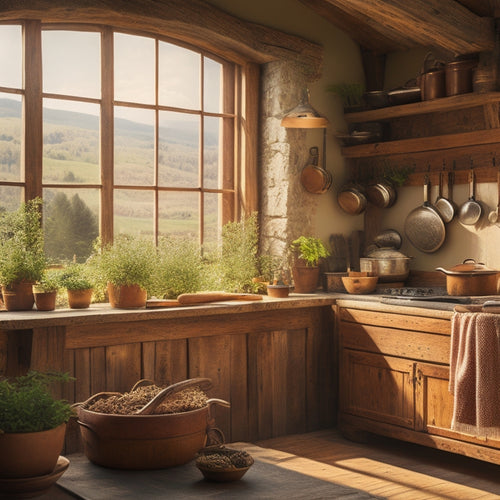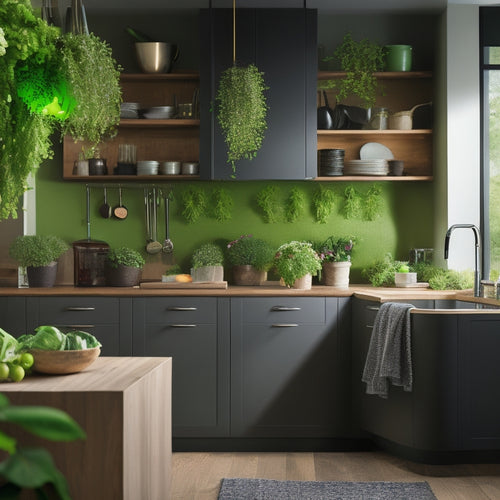
7 Best Kitchen Organization Digital Course Reviews
Share
You're tired of feeling overwhelmed in your kitchen, where clutter and disorganization sabotage your cooking experience. Finding the right digital course can transform your space into a haven of efficiency. Look for courses that teach you how to purge unnecessary items, maximize vertical space, and implement strategic storage solutions. A good course will show you how to create a kitchen zone system, streamline workflow efficiency, and customize storage solutions that fit your cooking style. By investing in the right digital course, you'll soon be whipping up meals in a kitchen that's not only organized but also safe and enjoyable. Now, discover which courses will get you there.
Key Takeaways
• Effective kitchen organization digital courses teach strategies for maximizing vertical space, utilizing hidden compartments, and implementing strategic storage solutions.
• A well-planned kitchen organization course should cover zone-based organization, assigning specific activities to each zone, and reducing stress in the kitchen.
• Look for courses that emphasize the importance of visibility and access in kitchen storage, keeping frequently used items visible and easily accessible.
• Top-rated kitchen organization digital courses should provide actionable tips on decluttering, purging unnecessary items, and implementing a 'one in, one out' policy.
• The best kitchen organization courses will also cover efficient kitchen layout and storage, including the 'golden triangle' concept and proper area placement for optimal workflow.
Decluttering Your Kitchen Essentials
Start by purging your kitchen of unnecessary items, tackling the countertops, cabinets, and drawers to create a more efficient workspace. This critical step will help you identify what you truly need and what's taking up valuable space. Be ruthless – if you haven't used it in the past year, it's likely taking up space that could be better utilized.
Next, focus on your pantry organization. Remove everything from the shelves and sort items into categories (baking supplies, canned goods, snacks, etc.). Discard expired or stale items and wipe down the shelves before putting back only what's essential. Consider installing shelves, bins, or baskets to maximize vertical space and keep similar items together.
Don't forget about your fridge layout. Take everything out and wipe down the shelves and walls. Sort items into categories (dairy, meats, leftovers, etc.) and store them in designated zones. Keep frequently used items front and center, and reserve the top shelf for infrequently used items.
Organizing Kitchen Cabinets Successfully
With your kitchen essentials decluttered and organized, you're now ready to tackle the often-daunting task of organizing your kitchen cabinets, where clutter and chaos can easily accumulate. Start by evaluating your cabinet space and deciding what items you want to store in each cabinet.
Consider implementing pantry organization systems, such as baskets or shelves, to maximize storage capacity. For spices, install spice rack solutions that keep them within easy reach and prevent clutter from building up.
Next, focus on your drawers. Install drawer dividers to separate utensils, cookware, and dinnerware, keeping them organized and preventing jumbled messes. When it comes to cabinet organization, think vertically. Use stackable shelves or baskets to store infrequently used items, freeing up space for more frequently used items.
Assign a home for each item, making it easy to find what you need when you need it. By following these steps, you'll be able to maintain a clutter-free and organized kitchen cabinet space, making cooking and meal prep more efficient and enjoyable.
Maximizing Kitchen Countertop Space
You'll want to make the most of your kitchen countertop space by implementing strategic storage solutions and decluttering habits to keep your countertops clear and functional.
One effective way to do this is by utilizing vertical storage options, such as installing shelves or cabinets that go up to the ceiling. This will help keep frequently used items within easy reach while keeping less-used items out of the way. Consider incorporating hidden compartments, like slide-out drawers or pop-up outlets, to keep countertops clutter-free.
Another smart approach is to take advantage of hanging storage solutions. Install hooks or a pegboard on a wall or under a shelf to hang items like pots, pans, utensils, or even a kitchen towel. This won't only free up counter space but also keep your kitchen organized and safe by preventing clutter from accumulating.
Additionally, consider using under-shelf storage baskets or bins to store items like spices, oils, or cleaning supplies. By implementing these strategies, you'll be able to maximize your kitchen countertop space, creating a more efficient and safe cooking environment.
Creating a Kitchen Zone System
By strategically dividing your kitchen into distinct zones, you can optimize workflow, reduce clutter, and make meal prep a breeze. This zone planning approach allows you to create a functional and efficient kitchen layout.
Start by identifying the main activities you perform in your kitchen, such as cooking, food preparation, and cleaning. Then, assign a specific zone to each activity, taking into account the tools and storage solutions needed for each task.
For instance, your cooking zone might include the stove, oven, and cooking utensils, while your food preparation zone could feature a countertop, sink, and storage for ingredients. Consider the 'golden triangle' concept, where your most frequently used items are within easy reach, reducing walking distances and increasing productivity.
Effective storage solutions, such as cabinets, drawers, and shelves, will help keep each zone organized and clutter-free. By implementing a well-planned zone system, you'll be able to navigate your kitchen with ease, reducing stress and increasing your overall cooking experience.
Streamlining Kitchen Workflow Efficiency
Streamlining Kitchen Workflow Efficiency
Optimizing your kitchen's workflow efficiency requires a keen understanding of how you move within the space, allowing you to identify and eliminate bottlenecks that hinder your productivity. By analyzing your daily habits and routines, you can pinpoint areas where you can streamline your workflow, saving you time and energy in the long run.
For instance, implementing a time-saving meal prep strategy can help you prepare healthy meals quickly and efficiently. This can be achieved by designating a specific area for meal prep, equipping it with the necessary tools and ingredients, and organizing your ingredients in an efficient pantry layout.
An efficient pantry layout is vital in streamlining your kitchen workflow. By categorizing and grouping similar items together, you can reduce the time spent searching for ingredients and cooking supplies. Additionally, consider the 'golden triangle' concept, where your cooking zone, sink, and refrigerator form the points of a triangle, allowing you to move quickly and safely between tasks.
Customizing Kitchen Storage Solutions
With a well-optimized kitchen workflow in place, it's time to turn your attention to customizing your kitchen storage solutions, where every item has its designated home, and you can effortlessly access what you need when you need it. This is where you'll create a tailored system that suits your cooking style and habits.
Start by evaluating your pantry organization - what items do you use frequently, and which ones can be stored out of the way? Consider installing shelves, baskets, or bins to keep similar items together and make the most of your pantry space.
Next, think about your drawers. Are they cluttered with utensils, cookware, and gadgets? Use drawer dividers to separate items into categories, making it easy to find what you need in a flash.
Maintaining a Clutter-Free Kitchen
To maintain a clutter-free kitchen, you'll need to develop habits that promote organization and tidiness. You'll start by clearing off countertops, getting rid of any unnecessary items, and leaving only what you use daily.
Clear Off Countertops
You'll be amazed at how quickly clutter accumulates on your countertops, making it important to establish a routine for regularly clearing off these high-traffic areas to maintain a clutter-free kitchen.
To achieve this, start by designating specific zones for appliance storage, keeping frequently used items within easy reach while storing less-used appliances in cabinets or on high shelves.
Next, adopt a minimalist design approach by removing any unnecessary items, such as decorative pieces or expired food items, and rearranging essential items to optimize counter space.
As you clear off your countertops, consider implementing a 'one in, one out' policy to prevent clutter from building up again. This means that for every new item you bring into your kitchen, you must remove or donate an old one to maintain a balanced level of possessions.
By establishing this routine and sticking to it, you'll be able to enjoy a safer, more efficient cooking environment that promotes productivity and reduces stress.
Assign Zones Wisely
By categorizing your kitchen into designated areas, you can create a functional layout that streamlines your workflow and keeps clutter at bay. Area placement is essential, as it directly impacts the organization and flow of your kitchen.
For instance, placing your cooking area near the oven and stove makes sense, while your prep area should be close to the sink and refrigerator. This thoughtful area positioning ensures that you can move efficiently between tasks, reducing the likelihood of accidents and increasing productivity.
When assigning areas, consider their functionality and flow. Think about the tasks you perform most frequently and group them accordingly. For example, if you bake often, dedicate an area to baking supplies and tools. This not only keeps items organized but also prevents clutter from building up in other areas.
Store Items Out
Incorporating a 'store items out' approach into your kitchen organization strategy enables you to maintain a clutter-free space by keeping frequently used items readily accessible and visible. This approach helps you avoid clutter buildup and reduces the risk of accidents in the kitchen.
By storing items out in the open, you'll be more likely to use them regularly, and it's easier to clean and maintain your kitchen surfaces.
When implementing this approach, start by designating specific areas for your frequently used items. For instance, allocate a specific shelf or basket for your pantry organization, and keep your most-used spices, oils, or condiments within easy reach.
Similarly, consider fridge organization by storing your most-used ingredients in the front and center of your fridge, making it easy to grab what you need when cooking.
Frequently Asked Questions
Can I Implement These Strategies in a Small or Rented Kitchen?
"You're not alone in wondering if kitchen organization strategies can work in small or rented spaces. Rest assured, you can implement space-saving ideas, apartment-friendly solutions, budget-friendly hacks, and creative storage solutions to maximize your kitchen's potential, regardless of its size."
Are These Courses Suitable for People With Mobility or Dexterity Issues?
When considering kitchen organization, you'll want to prioritize adaptability considerations and accessibility concerns, ensuring that your space accommodates your needs; look for courses that address mobility and dexterity issues, offering modifications for a safe, functional kitchen.
Will I Need to Purchase New Storage or Organizational Products?
"Oh, you're thinking of breaking the bank on new storage solutions, aren't you? Not so fast! You can repurpose items you already own and opt for budget-friendly solutions, embracing a minimalist approach with DIY hacks to maximize your kitchen's potential."
Can I Access the Course Materials on My Mobile Device?
You'll have seamless access to course materials on your mobile device, with offline access ensuring you can learn anywhere, anytime, and interactive quizzes to test your knowledge, all while enjoying compatibility with your device.
Are the Courses Taught by Professional Organizers or Experts?
You'll be relieved to know that the instructors guiding you through these courses are seasoned experts, boasting impressive credentials in their respective fields, ensuring the course content is meticulously crafted to provide you with actionable insights.
Related Posts
-

Rustic Hanging Racks for Country-Style Kitchens
Rustic hanging racks are a game changer for your country-style kitchen, blending functionality with charm. They maxim...
-

Rechargeable Under-Cabinet Lighting for Sustainable Kitchens
Rechargeable under-cabinet lighting is ideal for your sustainable kitchen. You'll enjoy energy efficiency with LED te...
-

Freestanding Pantry Units for Farmhouse Kitchen Style
Freestanding pantry units perfectly blend beauty and function in your farmhouse kitchen. They maximize storage while ...


